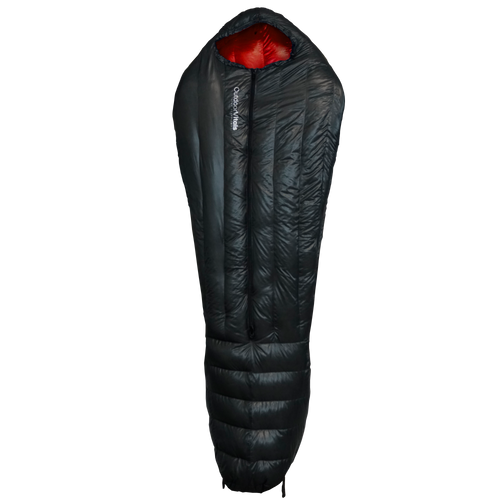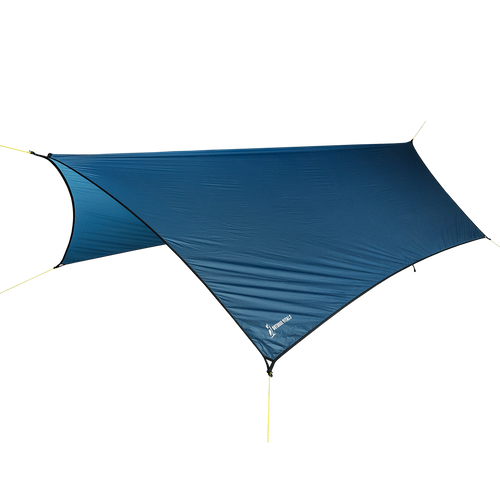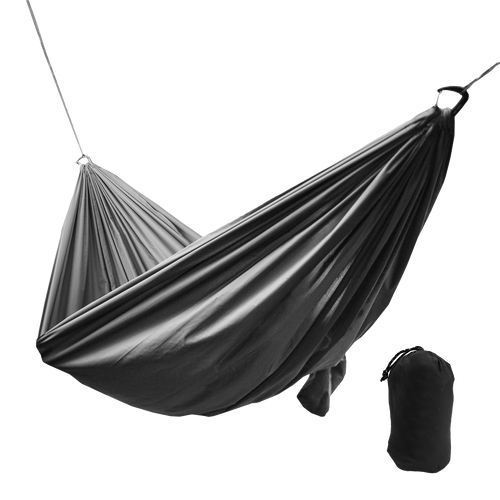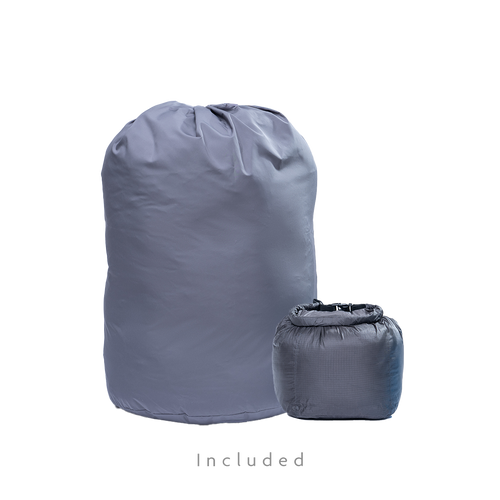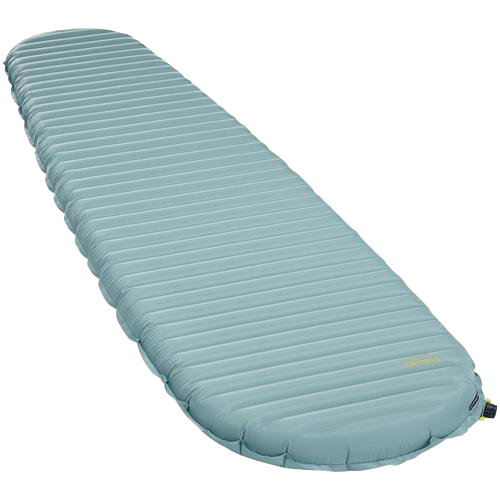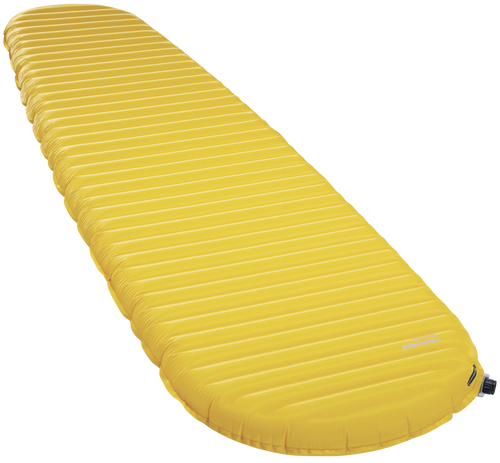Hammock vs Ground Camping
It seems that there is more and more discussion about hammocking versus ground camping. Is one better than the other? What are the advantages and disadvantages? What we’ll cover here is an objective approach to hammocking and ground camping, without any bias towards one or the other.
The weights and costs of gear for both setups are based on Outdoor Vitals gear, so there may be some variance depending on what you’re trying to use.
|
Hammock Setup Weights: Hammock and suspension: 16oz Tarp and stakes: 16oz Top quilt: 24oz Underquilt: 24oz (topquilt and underquilt in 20D fabric and 800 fill power down.) Total weight: 80oz. (5lbs) Costs: Hammock and suspension: $75 Tarp and stakes: $80 Topquilt: $150 Underquilt: $150 Total: $455 |
Ground Setup Weights: (using 20 degree bags, etc.) Summit 20: 40oz Sleeping pad: 23oz Tent (just footprint, poles, and rainfly): 2lbs Total weight: 95oz (5.9 lbs) Costs: Summit 20: $200 Sleeping pad: $75 Tent: $200 Total: $475 Lots of options to cut off costs. (if you use a tarp instead of a tent, you definitely can go way cheaper.) |
Hammock Setup
Advantages of Hammock Camping:
- Comfort: A hammock when set up in the correct way is easily the most comfortable way to sleep when camping. Sleeping on a diagonal in a hammock allows you to lay flat in one of the world’s most comfortable inventions.
- Consistency: Hammocks are very easy to set up consistently. You can get the same degree of the pitch almost every time. All you need is 2 trees. Sleeping in a hammock takes away the headache of fighting over the flattest piece of ground in the campsite.
- No Condensation: Everyone has woken up in the morning after sleeping in a tent and you feel muggy and wet. Your face or sleeping bag is pressed up against the side of a wet tent. This can all be avoided by camping with a hammock set up.
- Versatility: Sleeping with a hammock and tarp setup allows for a lot of versatility. You can set up your tarp high above your hammock so you can walk around or cook while still being out of the rain, or you can set up your tarp nice and tight above your hammock for maximum weather coverage.
- Bonus: Nap time! Who doesn’t love a quick nap in a hammock? Whether you set it up at lunchtime or take a quick nap when you get to camp. A hammock allows you a quick and easy solution to a back-country nap.
Disadvantages of Hammock Camping:
- Trees: One of the biggest disadvantages of hammock camping is the fact that you need two trees to hang from. While there are plenty of trees in the outdoors there are some areas that may not have them.
- Coverage: Coverage is key when it comes to bad weather camping. While a tarp can provide great protection it is not ideal for heavy rain and snow camping.
Sleep systems for a hammock
As discussed before, a great setup for sleeping in a hammock is to use an underquilt and a topquilt. Underquilts wrap underneath the hammock to keep you insulated underneath and prevent “cold butt syndrome”, and the top quilt will keep the rest of you warm inside the hammock.
The reason you couldn’t just use a regular sleeping bag by itself in a hammock is that as you are inside the bag, your body weight compresses all the insulation underneath you. Compressed like this, there aren’t any air pockets in the insulation, and it loses its insulating ability. You’ll get cold pretty easily.
One alternative some people have used is to sleep with an insulated pad and a sleeping bag in the hammock. This works as long as you can stay on top of the pad and it doesn’t slip out. If you use an inflated pad, deflate it just a little so the pad can form to the shape of the hammock a little better. Then it won’t slip out as easily.

Whatever setup you're using, a hammock bugnet is something to consider getting to make sure those mosquitoes stay away! Bugnets are typically designed to go around your whole hammock sleep setup and connect to the carabiners of your hammock or to the trees or suspension system your hammock is hanging from. They are pretty lightweight and make a huge difference.
It’s also a good idea to bring along a tarp as protection from the weather while hammock camping. You wouldn’t want to be caught soaking wet in a rainstorm, especially if you’re using a down insulation sleep system. Down loses its insulating ability when wet. So tarps are pretty necessary, and add to the overall weight of using a hammock sleeping system.
Bonus: The NEW Outdoor Vitals Top Quilt

I couldn’t move on without telling you about Outdoor Vitals Top Quilt. This is by far what I believe is the BEST insulation option for hammock camping (you'll need the under quilt as well for this) OR ground camping!
Outdoor Vitals has designed it to be more approachable to those who have never used a top quilt. This quilt will help keep you warm at night by eliminating drafts, give you extra room in the shoulder and torso area, and lighten your pack. They added a larger boxed draft collar and tapered the top of the quilt, a new design that will prevent drafts on those colder nights and give you peace of mind when switching to a quilt or improving the ability to eliminate drafts from your current quilt.
The quilt's redesign includes:
- Boxed Draft Collar
- Tapered Design to eliminate drafts
- Extra fill for warmth
- 2 locations for straps in the back to seal you to your pad.
- Sealed foot box to designed to fit the shape of your feet and legs while sleeping.
Check out this podcast to deeper understand our new top quilt: Just click on the photo and find Ep 53 on our site.
Sleeping straight vs diagonal
Sleeping diagonally in a hammock typically requires a larger hammock, like a double hammock. But using a sleep setup like a MummyPod™ is better with a single hammock. These single hammocks typically just allow you to sleep with a straight lay. Some people consider this to be an issue and have 3 main concerns with a straight lay.
Concerns of straight:
- Your body is bent (like a banana)
- Knees are hyperextended
- Body squeezed by the hammock
These concerns can be overcome. To get a flatter lay, hang the hammock a little tighter (at least a 30 degree angle, maybe a bit smaller).
To overcome hyperextended knees, put something behind them. A jacket will work, but an inflated backpacking pillow is pretty much perfect for the job. Getting your knees bent a bit like that also changes the position of your back. Your back lays flatter instead of having so much of an arc.
To overcome being squeezed, lay with your shoulders in the widest part of the hammock. Your feet can be closer to the gathered end, which will put your shoulders close to the middle, where there is more hammock. That way there will be less squeeze.
Ground Setup
Benefits of Ground Camping:
- Coverage: A tent provides maximum coverage from bad weather as it is a completely enclosed shelter. A tent can be your home away from home when you experience bad weather on the trail. It is a place where you can relax and spread out your gear, a little hang-out spot for a night full of rain or snow.
- Warmth: A tent can add a layer of warmth on those colder nights by helping keep you out of the cold winter drafts. Tents can trap in that warm air a lot more than a hammock setup. Allowing you to take off wet clothes and stay warm and toasty all night.
- Security: Most people feel more secure and comfortable with tents. People tend to be more comfortable with what they are familiar with.
Disadvantages of Ground Camping:
- Condensation: As mentioned before tents tend to build up condensation throughout the night. This can even create a need to pull your tent out during the day to allow it to dry out. To help avoid condensation look for a two-walled tent vs a single-wall tent.
- Cleaning: We all have gotten mud or dirt inside of our tent and shaken it all day to try to clean the inside of our tent. It is not easy. Hammocks are a lot easier to clean and shake out when they get dirty.
- Set up times: With most tent setups you not only have to set up your tent, but you also have to blow up your air mattress. This can take time and make tents a little more time-consuming than a hammock system.
Sleeping systems for Ground Camping
A tent and sleeping bag isn’t the only option while ground camping, although they are a great way to go! If you’re looking for fast and light, hammock camping is not your only option. There are also systems like teepees, tarp shelters, etc. that can work great for sleeping on the ground.

Let’s start with the classic: tents. While there are lightweight backpacking options for tents, they do tend to be a little heavier than other ground camping alternatives. Packing around the tent body, poles, stakes, fly, and footprint can weigh a lot! You can also go in fast and light mode, which is basically the footprint, fly, and poles, and that cuts out some weight, but will give you less protection. One of the biggest advantages a tent can give you is that protection, since most tents have a bathtub floor, a bugnet, and really isolate you from the weather.
Teepees are similar to tents, and maybe a little lighter. But they usually don’t have a floor attached, and while they give you good coverage above and around you, you aren’t protected from underneath. Another thing to know about teepees is that the high point is right in the center, and the walls of the teepee slope down from there. This give you a lot of headspace in the center of the teepee, but not so much when you are laying down. The wall of the teepee will be right by your head, and your feet might sometimes be right into the wall as well.
Tarps are great for an ultralight and easy setup. You can use trekking poles on each end of the tarp to prop it up with cords and stakes holding the sides out. You can also tie the tarp to trees and branches if they are available instead of using trekking poles. Tarp shelters are extremely versatile and you can adjust them to form barriers against wind, snow or rain if there is some directional precipitation or wind. Tarps can also come in different shapes making them useful in different situations. Outdoor Vitals has both 4-sided tarps and 6-sided hex tarps. 
Bivys are also used in ground camping. They are basically the same size of your sleeping bag, and don’t give you much room to move around in. They are not the best stand-alone sleep system, but work great with a tarp. One thing to check with a bivy is breathability. Some are completely waterproof, which means if you sweat at all at night, you’ll be stuck with that condensation, and will most likely be cold. A good bivy should have a waterproof bottom with a water-resistant top, and vents for breathability.
With all of these sleep systems, you’ll want an insulated pad along with a sleeping bag or topquilt. Being on the ground doesn’t eliminate the need to be insulated from underneath as well as above. However, unlike in a hammock, sometimes you can use things like leaves and pine needles to help insulate you from underneath if you don’t have a pad available.
Do What Works Best For You
Different circumstances like climate, weight or money limitations, and environment are also factors. A basic hammock and ground camping setup are pretty similar in weight and cost as you can see from the table towards the beginning of this article. But as you start tweaking those basic setups with gear more suited to your needs and situation, those weights and costs can change by quite a bit.
Knowing your 4 T's can help you know what setup will work best for you. These are Terrain, Temperature, Time, and Troubles. Know what kind of terrain and environment you'll be in, what the temperature will be like, how long you'll be there, and what potential troubles you could run into like bears, snowstorms, or heat.
Trying out a couple of these different setups, you may find one you simply like better than the others. Great! There's no one right answer. As long as you are outdoors and enjoying it, then I'd count it as a success!
2 comments
I appreciate you informing us that while teepees provide good head coverage, they don’t have floor protection attached, so it’s best to consider that if you plan to use them for camping. My friends and I are going camping in the woods next week, and we were thinking of setting up luxury private nomad tents. I’ll be sure to get floor protection for us while I look for where we can avail of teepees in our area. https://outbackedges.com/outback-vacation-2022
just to be clear, everyone is different and what works for one does not always work for everyone. I prefer hammock but when there is doubt on the trees in an area I will also pack in my one man bevy. just in case. most of my stuff transfers over from hammock to ground tent. but that is what I do

